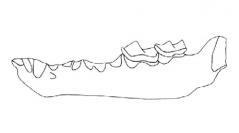

 Comptes Rendus Palevol
15 (6) - Pages 669-680
Comptes Rendus Palevol
15 (6) - Pages 669-680The Ciota Ciara cave is located within the Monte Fenera karst system (Borgosesia, Vercelli, Italy) at 670 m a.s.l. The cave entrance presents a deposit with Mousterian quartz and flint industry. The faunal remains from Stratigraphic Units 13, 14 and 103 are the subject of this work and are presented here as a whole for the first time. The large mammal assemblage is dominated by Ursus spelaeus. In addition, a few remains of carnivores such as Panthera leo spelaea, Panthera pardus, Meles meles have been found together with ungulates such as Cervus elaphus and Rupicapra rupicapra. The small mammal assemblage is characterized by a high biodiversity, especially in bats, by the dominance of Clethrionomys glareolus and by a relatively large number of Pliomys coronensis, a species that seems to disappear from the Italian Peninsula at the end of Marine Isotope Stage 5 or during the beginning of MIS 4. The changes in frequency of the small and large mammals between the two S.U. suggest a change from a relatively cold-humid (S.U. 14) to a warmer-still humid climate (S.U. 13). Although no radiometric dates are available yet, the small and large mammal assemblages, the presence of Pliomys coronensis and the climate change inferred by the variation of the small mammal frequencies allow us to correlate these two units of the Ciota Ciara cave to a relatively warm moment of Marine Isotope Stage 5.
Large mammals, Small mammals, MIS 5, Italian Peninsula